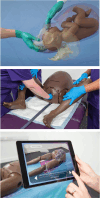Training for managing impacted fetal head at caesarean birth: multimethod evaluation of a pilot
- PMID: 37524515
- PMCID: PMC10391817
- DOI: 10.1136/bmjoq-2023-002340
Training for managing impacted fetal head at caesarean birth: multimethod evaluation of a pilot
Abstract
Background: Implementation of national multiprofessional training for managing the obstetric emergency of impacted fetal head (IFH) at caesarean birth has potential to improve quality and safety in maternity care, but is currently lacking in the UK.
Objectives: To evaluate a training package for managing IFH at caesarean birth with multiprofessional maternity teams.
Methods: The training included an evidence-based lecture supported by an animated video showing management of IFH, followed by hands-on workshops and real-time simulations with use of a birth simulation trainer, augmented reality and management algorithms. Guided by the Kirkpatrick framework, we conducted a multimethod evaluation of the training with multiprofessional maternity teams. Participants rated post-training statements about relevance and helpfulness of the training and pre-training and post-training confidence in their knowledge and skills relating to IFH (7-point Likert scales, strongly disagree to strongly agree). An ethnographer recorded sociotechnical observations during the training. Participants provided feedback in post-training focus groups.
Results: Participants (N=57) included 21 midwives, 25 obstetricians, 7 anaesthetists and 4 other professionals from five maternity units. Over 95% of participants agreed that the training was relevant and helpful for their clinical practice and improving outcomes following IFH. Confidence in technical and non-technical skills relating to managing IFH was variable before the training (5%-92% agreement with the pre-training statements), but improved in nearly all participants after the training (71%-100% agreement with the post-training statements). Participants and ethnographers reported that the training helped to: (i) better understand the complexity of IFH, (ii) recognise the need for multiprofessional training and management and (iii) optimise communication with those in labour and their birth partners.
Conclusions: The evaluated training package can improve self-reported knowledge, skills and confidence of multiprofessional teams involved in management of IFH at caesarean birth. A larger-scale evaluation is required to validate these findings and establish how best to scale and implement the training.
Keywords: Cesarean delivery; Healthcare quality improvement; Medical education; Obstetrics and gynecology; Simulation.
© Author(s) (or their employer(s)) 2023. Re-use permitted under CC BY-NC. No commercial re-use. See rights and permissions. Published by BMJ.
Conflict of interest statement
Competing interests: None declared.
Figures


References
Publication types
MeSH terms
LinkOut - more resources
Full Text Sources
